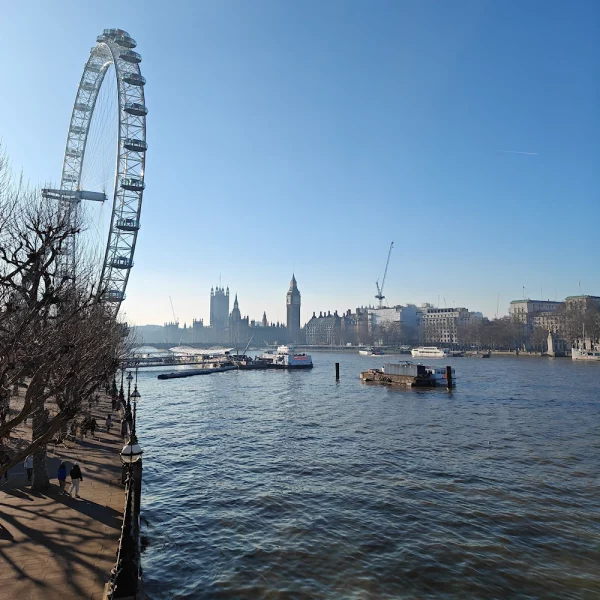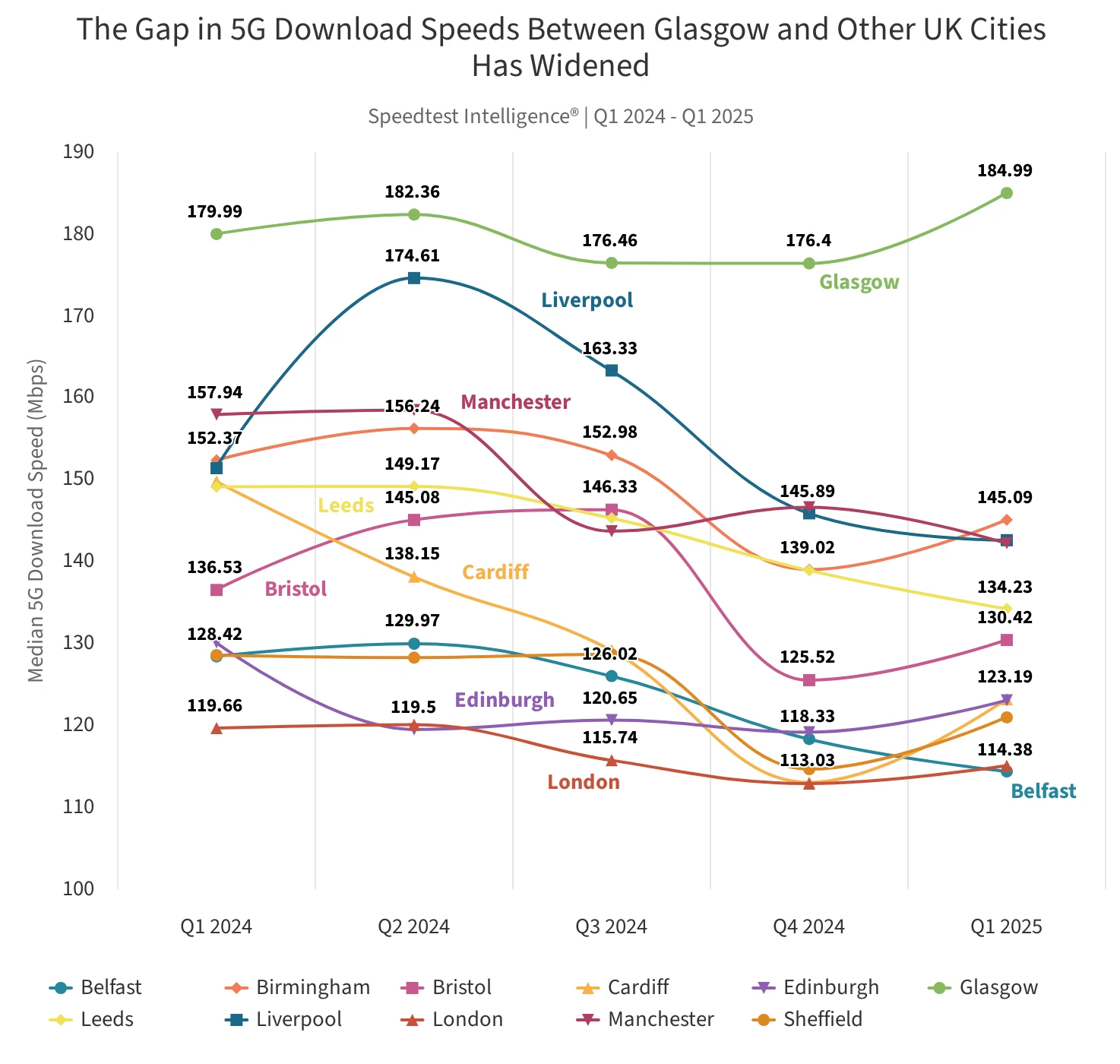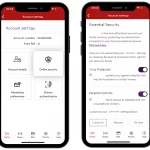Ookla Study Finds London 5G Mobile Performance Lags Behind Other UK Cities

Network testing firm Ookla (i.e. Speedtest.net, Downdetector.co.uk) has today published a new study that examines the performance of 5G mobile (mobile broadband) networks across the major UK cities of Belfast, Birmingham, Bristol, Cardiff, Edinburgh, Glasgow, Leeds, Liverpool, London, Manchester and Sheffield. But the UK’s capital city was found to be lagging behind.
The new study uses crowdsourced data collected during the first quarter of 2025 via Ookla’s various Speedtest.net linked websites and apps. But it’s worth reminding readers that mobile data performance remains notoriously difficult to pin down because end-users are always moving through different areas (indoor, outdoor, underground etc.), using different devices with different capabilities and the surrounding environment is ever changeable (weather, trees, buildings etc.).
All the above can impact your signal and service quality, and that’s before we even consider other issues like network (backhaul) capacity at different cell sites or differing spectrum ownership between operators and masts. Suffice to say that benchmarking mobile networks can be a bit of a challenge, although Ookla are usually able to collect enough data to produce some meaningful results.
Advertisement
Overall, the new study found that London “lags behind the UK’s largest cities across key 5G performance indicators“, and the gap to top-performing Glasgow seems to be widening. The UK’s capital city was found to be trailing behind other cities for 5G network consistency, median downloads and upload speeds (e.g. London delivered a median 5G download of 115Mbps, which compares poorly with Glasgow’s 184.99Mbps).
On the flip side, median (average) 5G download speeds also fell by more than 7% on average across major UK cities between Q1 2024 and Q1 2025. This is speculated to be reflecting the impact of shifting network load from older technologies onto 5G (e.g. the withdrawal of 3G), which contributed to broader improvements in overall mobile network performance in most UK cities during the same period.

Average (Median) 5G Download Speed by Major UK Cities
Glasgow 184.99Mbps
Birmingham 145.09Mbps
Liverpool 142.61Mbps
Manchester 142.24Mbps
Leeds 134.23Mbps
Bristol 130.42Mbps
Cardiff 123.19Mbps
Edinburgh 123.05Mbps
Sheffield 120.98Mbps
London 115.08Mbps
Belfast 114.38Mbps
Mobile users in London were also found to be spending more time in signal not-spots with no service than residents of other UK cities, reflecting “lingering coverage gaps indoors and across key transport routes“. The proportion of Londoners spending the majority of their time in locations with no service has, however, improved significantly due to operators investing in network densification through small cells and upgrades to transport links (e.g. London Underground).
Advertisement

Time spent on 2G networks increased across several UK cities over the last year, including Birmingham and Manchester, as the advancement of the 3G sunset in the UK contributed to greater propensity for 2G fallback.

However, the gap in 5G availability between the UK’s major cities and the national average has significantly narrowed over the past year. For example, Leeds led UK cities in 5G availability, with a 21 percentage point gap above the national average. By Q1 2025, London had taken the lead in 5G availability among major UK cities, and that gap above the national average had narrowed to 13 percentage points.
Advertisement
This trend reflects progress in 5G network expansion in smaller UK towns and rural areas in recent months, which has moved at a faster pace than coverage improvements in larger cities. But sadly we don’t get a more detailed summary of 5G availability across the listed cities, which would have been helpful.
Mark is a professional technology writer, IT consultant and computer engineer from Dorset (England), he also founded ISPreview in 1999 and enjoys analysing the latest telecoms and broadband developments. Find me on X (Twitter), Mastodon, Facebook, BlueSky, Threads.net and Linkedin.
« EE UK Launch Tech Drops – Giving Big Discounts on Modern Technology























































Because the mast rollout has been effectively paused.
Anyone know why? Starlink solution incomming?
Starlink ‘cells’ cover areas of dozens of square kilometers, containing potentially hundreds of thousands of people – more than one can cover.
London is uniquely dense, and cell densification is the only solution, covering areas of only a few hundred square meters, and a thousand or so people – look at the rollout of small cells that all operators are currently undergoing
One of the problems London face is the very high population density meaning a lot more masts are needed. Lots of vey high building can also present coverage challenges. 5G is very much line of sight and any high buildings will block the signal or at very lease attenuate it
It lags because there are less masts in less places – because of .w factors:
1) Londoners object to pretty much every planning application for 5g masts
2) councils reject applications because the mast is in the “wrong place” or “too high” even when the MNOs prove there are no other suitable locations.
Couple of other reasons to consider. A recent Cheltenham court case ruled that councils can consider safety, which is a complete minefield given ICNIRP’s loose assurances on safety.
ICNIRP does state that masts should be at least 50meters from dwellings (exclusion zones), this has not happened in the U.K.
The new adult government will be dealing with this toxic problem it’s been gifted.
You’re right. People want decent 5g coverage but don’t want new mast nearby.
Yet the providers have been able to make substantial progress in growing network capcity.
@Stacey Mountfield: Would that be the adult government that just published the bill without any mention at all about the needs of wireless network providers, and which recently cut funding for addressing wireless not spots?
Well… Everything else is lacking in other cities – so I’m not feeling much sympathy for Londoners. Most other city centre are dying out – that’s probably why network congestion isn’t an issue
Would the steady decline in download speeds to Q4/2024 have more to do with the roll-out of additional 5g capacity lagging the growing take-up of 5g capable devices due to the timing of Ofcom’s authorisation of 5G SA deployments?
Ookla will disagree, but I think these metrics are meaningless.
Firstly, they rely on on crowdsourcing by users who install and app/carry out a speed test.
But the real issue is that these are burst speeds. I.e. the network will temporarily provide excess bandwidth during the test as a large amount of data is requested from it.
In real world no user actually uses anywhere near the sort of bandwidth these tests are reporting as a theoretical maximum.
Most users mobile devices wont ever require or demand more than 5Mbs for most use cases perhaps 15Mbs if they are streaming video.
None of the mobile networks or fixed line ISPs ever report to users how much bandwidth they are actually using, and with good reason as customers would question why they need to pay for supposed ever increasing bandwidth tiers.
It would be far better useful to measure and report on ubiquity or lack of it in terms of coverage and capacity.
But you’re not going to do that via crowd sourced data from an installed base of random users like Ookla does. It needs to be done via drive testing and collecting real world data at consistent and granular intervals.
London is a huge mega city and litterally has millions of users all connecting to these networks so I would say it’s doing ok considering.
But London is also a huge diverse area, a small country really. So, are we saying that the results from Ookla are just for central London, urban London, or all of London?
I have tested my O2 connection on a Samsung s23+ (fully patched) in: Central, West, SE, NW and East London, speeds are atrocious.
Same goes for family and friends on: EE, Three and Vodaphone.
5G speeds is no obtainable in the majority of London.
My experience is very different. I get broadband speeds across most of London on EE.
There’s a bigger problem in London. No network can provide you with a working data connection everywhere. I’m talking about basic data over any “G”. You can be sure that you’ll have, let’s say, at least 2Mbps. No single network can do it.
Vodafone and EE seem to be the most reliable, but even they have issues in some places, and EE struggles with signal indoors. Three is all over the place. O2 has the coverage and works for calls, but you can go from acceptable speeds to nothing loading in 200 meters, from acceptable latency to 2G performance on 4G.
Those visiting might not notice it, but if you work and live here, don’t spend all your time in fancy areas, and have to move around, the experience can be bad. I use two networks and sometimes it’s not enough.
I have no issues with getting an indoor signal from EE in London. Are you referring to steel framed buildings?
Across London, so many people are complaining about rubbish speed and call quality, so the fan boy will always try and fail to convince anyone. This was confirmed by all my family an friends inside and outside while walking.